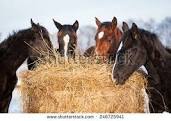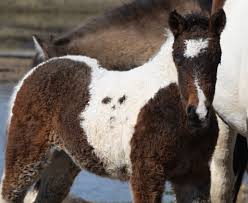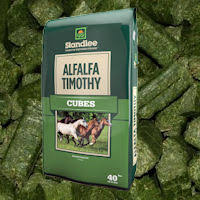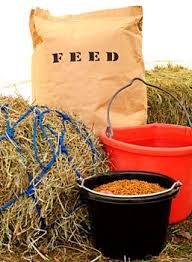Cold weather is right around the corner, which means the grass is dying off, and hay is needed to keep members of the equine family fed. Are you aware that the change in the weather also brings a change in a horse’s nutritional needs, as well? If not, you’ll need to prepare your horse now before it is too late!
You might ask, why do I need to adjust for cold weather? Well, think about it this way … it is easier to keep weight on a horse in the winter than to have him gai n it once he’s gotten skinny – do whatever you can to not let that happen. Believe it or not, it is not impossible to keep him warm and healthy with some extra care.
n it once he’s gotten skinny – do whatever you can to not let that happen. Believe it or not, it is not impossible to keep him warm and healthy with some extra care.
By this point in the season, your horse should have bulked up already and have a nice layer of fat underneath that fuzzy coat. Think of that extra fat as a “reserve” just in case a winter bug enters your b arn and makes your horse sick. After all, not everyone can bring their sick horse in the front door of their house to stay warm and recover, as I did – many, many, MANY years ago.
arn and makes your horse sick. After all, not everyone can bring their sick horse in the front door of their house to stay warm and recover, as I did – many, many, MANY years ago.
Now, if you are not planning on bringing your equine partner into the house, the digestion of fiber (hay) in your horse’s digestive tract creates heat that will help keep him warm. Be sure to have plenty of hay for him to munch on all day in the cold winter months. I have a couple horses that will gobble every little bit of hay in one fell swoop, no matter the amount I might put in front of them, instead of munching on the pile periodically throughout the day. Fortunately, I have the luxury of “haying” throughout the day; 8 AM, 12 Noon, 3 PM (during winter months only), 6 PM, and 11 PM. Yes, that totals five times per day – I much prefer to keep those digestive tracts constantly moving with hay rather than an expensive emergency vet call for an impacted colic. If you are not able to hay throughout the day, are you able to leave hay for free access? FYI, if your barn is not already full, buy hay as early as you can, prices get higher as winter goes on.
If you are like me, and happen to have a few senior citizens in your barn that have poor teeth and struggle with hay, you can feed soaked alfalfa cubes or hay pellets (pellets can be used as a filler NOT a replacement). However, I much prefer to feed my seniors second and third cutting hay since it generally has less stem and more leaf, making it a little easier to chew.
NOT a replacement). However, I much prefer to feed my seniors second and third cutting hay since it generally has less stem and more leaf, making it a little easier to chew.
Many horse owners once believed that they needed to feed rations containing more corn in the cold months, thinking of corn as a heating feed. However, adding corn oil to his regular grain meal or using other cereal grains does not cause the horse to become warmer, they just add extra calories. Hay, which contains more fiber than grain provides more of a warming effect internally, since more heat is released during the digestion of fiber than of starch from grain. Therefore, horses are able to maintain body heat if hay is available throughout the day.
Feeding an additional ¼ lb. of grain per 100 lb. body weight to “non”working horses will provide enough calories during cold, windy and wet weather. If you choose to increase grain, just don’t increase it to an unhealthy level, it is better to change to a feed with a higher fat content, standard is 2.5% to 4.5% but you can find grain with as much as 10% fat. But, not every horse needs additional rations.

Out of the seven horses in my barn, I only increase the grain intake for the three oldest (ages 30, 28 and 21), the rest maintain weight just fine with their regular rations and additional hay. And when I say increase the grain intake, that means I add an additional grain feeding time/times (Noon and 11 PM), not an increased amount at the usual 8 AM and 6 PM feedings.
Fresh, clean water is just as important in the winter months, as it is in the summer months. A horse will require a lot more water when eating dried feedstuffs like hay, compared to grazing on lush pastures. If the water is ice cold, the horse will not drink as much, so if possible, provide access to clean “warm” (45-64 degrees F) water. At the very least, be sure the water remains unfrozen and monitor your horse’s intake, a horse that doesn’t drink enough in the winter is at risk for colic.
I know we are talking about cold weather “feeding” tips, but I don’t want any of you to keep your horse in the stall, thinking standing in the warmth is better than exercise in the cold. Your horse absolutely needs to get out of that stall and move, even if it is only 20 to 30 minutes per day. If you don’t have safe turnout, can you lunge, or at the least walk/trot? My father built an indoor arena way back in the 60’s, so the importance of daily exercise for every horse in the barn was the norm of my youth. Fast forward to the 90’s when I built my own indoor arena, which I loving refer to as my “winter pasture”. It is where my horses enjoy a daily four hour turnout just like they do in their grass pastures throughout the summer months. The only difference is that they “graze” on hay spread around the arena November through April vs grass in the pastures the other six months.
I’ve spent a great deal of time talking about the importance of hay and water, but don’t forget the salt. It is an important element, as well. Free access to salt and minerals will encourage frequent usage and will also encourage visits to the water bucket.
Finally, the only other suggestion I can give is to make sure your horse has been wormed BEFORE winter arrives. This will kill any parasites that might prevent your horse’s optimum digestion and hamper his warmth.
Keeping these tips in mind might just help your horse emerge from winter healthy AND in good weight.